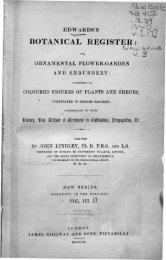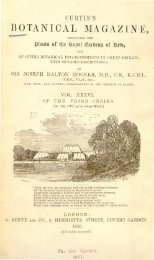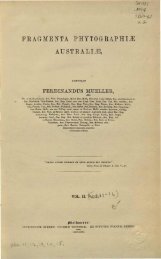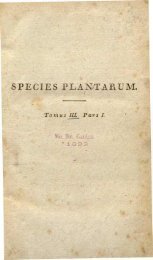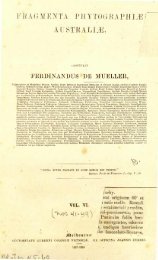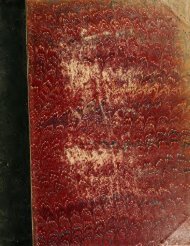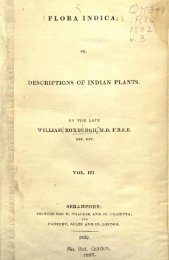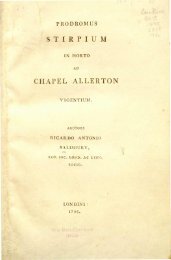Analyses for Flavonoid Aglycones in Fresh and Preserved Hibiscus ...
Analyses for Flavonoid Aglycones in Fresh and Preserved Hibiscus ...
Analyses for Flavonoid Aglycones in Fresh and Preserved Hibiscus ...
You also want an ePaper? Increase the reach of your titles
YUMPU automatically turns print PDFs into web optimized ePapers that Google loves.
Herbs, Medic<strong>in</strong>als, <strong>and</strong> Aromatics<br />
bases 2002). For all the other native American endemic species of <strong>Hibiscus</strong>, however, there is little or no<br />
phytochemical data. The Old World <strong>Hibiscus</strong> species (<strong>and</strong> many other genera with<strong>in</strong> the Old World Malvaceae),<br />
however, are well documented. The lack of data <strong>for</strong> North American Malvaceae genomes is one of the driv<strong>in</strong>g<br />
<strong>for</strong>ces beh<strong>in</strong>d the chemical <strong>in</strong>vestigations we have pursued <strong>in</strong> recent years, many of which are documented<br />
here<strong>in</strong>. Without such data, we cannot move ahead with development of our <strong>for</strong>mulations of <strong>Hibiscus</strong> valueadded<br />
food products <strong>and</strong> sk<strong>in</strong>-care <strong>for</strong>mulations.<br />
In addition to edible pigments, all of the North American endemic species also have good yields of <strong>in</strong>dustrial<br />
fibers, as do all of the non-endemic species <strong>and</strong> varieties listed <strong>in</strong> Table 1. In addition, the roots <strong>and</strong><br />
flowers of many of these species have been used to make root <strong>and</strong> flower teas, <strong>and</strong> have shown activity aga<strong>in</strong>st<br />
tumors, viruses, <strong>and</strong> cancers. All species are also very mucilagenous <strong>and</strong> many (if not all) have been used <strong>for</strong><br />
centuries <strong>in</strong> many countries—<strong>in</strong>clud<strong>in</strong>g the US—as demulcents, emollients, nerv<strong>in</strong>es, <strong>and</strong> stomachics, as well<br />
as <strong>in</strong> the treatment of dysentery, lung, <strong>and</strong> ur<strong>in</strong>ary ailments. In the US, Kosteletskya has been used as a potherb<br />
(leaves) <strong>and</strong> flowers are eaten uncooked. Roots have been used as vegetables (cooked) <strong>and</strong> can be ground,<br />
made <strong>in</strong>to a paste <strong>and</strong> roasted to make “marshmallows;” teas may be made from the flowers, <strong>and</strong> any part of<br />
the plant can be boiled <strong>and</strong> used as an egg-white substitute <strong>for</strong> mak<strong>in</strong>g mer<strong>in</strong>gues (the root, flower <strong>and</strong>/or stem<br />
sugars <strong>and</strong> mucilages are extracted <strong>and</strong> concentrated by boil<strong>in</strong>g <strong>in</strong> water).<br />
Other species that we currently grow (or have grown) have similar efficacies (Plants <strong>for</strong> a Future 2002;<br />
Dr. Duke’s Phytochemical <strong>and</strong> Ethnobtanical Databases 2002). These <strong>in</strong>clude H. mutabilis <strong>and</strong> H. paramutabilis,<br />
H. rosa-s<strong>in</strong>ensis, <strong>and</strong> H. syriacus. We have also grown several annual <strong>and</strong>/or biennial species (such as H.<br />
acetosella, H. cannab<strong>in</strong>is, <strong>and</strong> H. sabdariffa), but are concentrat<strong>in</strong>g on perennial <strong>and</strong> tree-type Malvacea because<br />
of the much greater potential <strong>for</strong> susta<strong>in</strong>able agriculture with these long-lived species.<br />
The results of previous <strong>in</strong>vestigations of nutritional analyses of dehydrated petals (analyses per<strong>for</strong>med<br />
by Siliker Laboratories, Dallas, Texas) <strong>in</strong>dicate substantial yields of dietary prote<strong>in</strong>s, sugars, fiber, <strong>and</strong> unsaturated<br />
fats, as well as most of the major dietary vitam<strong>in</strong>s. These could be recovered from floral harvests on a<br />
commercial basis. Applications may <strong>in</strong>clude use of whole fresh, dried (dehydrated or freeze-dried), or frozen<br />
petals <strong>for</strong> use <strong>in</strong> nutraceutical products <strong>and</strong> specialty gourmet foods, or as a base <strong>for</strong> extraction of natural food<br />
colorants <strong>for</strong> applications <strong>in</strong> foods <strong>and</strong> beverages. Other applications <strong>for</strong> fresh <strong>and</strong> processed blossoms <strong>and</strong><br />
their extractions may <strong>in</strong>clude <strong>for</strong>mulation of cellulosic <strong>and</strong> mucilagenous dietary products, transdermal carriers<br />
<strong>for</strong> non-alimentary drug delivery, <strong>and</strong> sk<strong>in</strong>-care <strong>for</strong>mulations.<br />
REFERENCES<br />
Dr. Duke’s Phytochemical <strong>and</strong> Ethnobotanical Databases. www.ars-gr<strong>in</strong>.gov/duke/ethnobot.html. April 2002<br />
Merken, H.M. <strong>and</strong> G.R. Beecher. 2000. Liquid chromatographic method <strong>for</strong> the separation <strong>and</strong> quantification<br />
of prom<strong>in</strong>ent flavonoid aglycones. J. Chrom. A. 897:177–184.<br />
Kim, J.H. <strong>and</strong> K. Fujieda. 1991. Studies on the flower color variation <strong>in</strong> <strong>Hibiscus</strong> syriacus L.: Relation of<br />
flower colors to anthocyan<strong>in</strong>, pH <strong>and</strong> co-pigmentation. J. Kor. Soc. Hort. Sci. 32:247–255.<br />
Kurilich, A.C., G.J. Tsau, et al. 1999. Carotene, tocopherol, <strong>and</strong> ascorbate contents <strong>in</strong> subspecies of Brassica<br />
oleracea. J. Agr. Food Chem. 47:1576–1581.<br />
Ishikura, N. 1973. Anthocyan<strong>in</strong>s <strong>and</strong> flavonols <strong>in</strong> the flowers of <strong>Hibiscus</strong> mutabilis F. versicolor. Kumamoto<br />
J. Sci. Biol. 11:51–59.<br />
Ishikura, N. 1982. Flavonol glycosides <strong>in</strong> the flowers of <strong>Hibiscus</strong> mutabilis F. versicolor. Agr. Biol. Chem.<br />
46:1705–1706.<br />
Ohmoto, I.T., K. Yamaguchi, <strong>and</strong> K. Ikeda. 1988. Constituents of <strong>Hibiscus</strong> moscheutos L. Chem. Pharm.<br />
Bul. 36:578–581.<br />
Plants <strong>for</strong> a Future: Database Search Results. www.scs.leeds.ac.uk/cgi-b<strong>in</strong>/pfaf/arr_html<strong>Hibiscus</strong>+moscheutos.<br />
April 2002.<br />
Subramanian, S.S. <strong>and</strong> A.G.R. Nair. 1972. <strong>Flavonoid</strong>s of four Malvaceous plants. Phytochemistry 11:1518–<br />
1519.<br />
563




